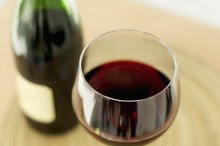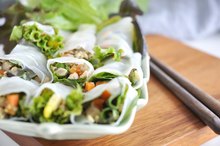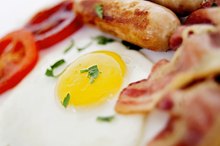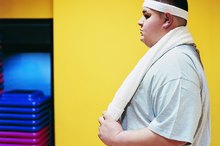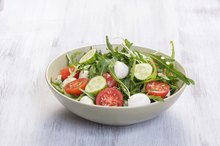Somersizing Diet Plan Tips
The Somersize Diet was developed by Suzanne Somers and was first introduced in her 1996 book, "Eat Great, Lose Weight." The diet has been revised through the years but the same philosophy maintains that, "Fat is your friend, and sugar is the greatest enemy," says Somers 12. The plan can be classified as a high-fat, low-carbohydrate diet, but it also includes combining foods in a way that is believed to aid in digestion and weight control.
Eliminate Funky Foods
As explained in her book "Suzanne Somers' Fast And Easy," the first step is to eliminate foods that could raise insulin levels in the body and prevent or slow weight loss 12. These foods are called "Funky Foods," and they consist of all sugar products and foods that are high in starch. This includes white flour, potatoes, white rice, corn and all alcohol.
Food Groups
Balanced Oxidizer Diet
Learn More
The normal, everyday foods that can be eaten are divided into four Somersize Food Groups--Pro/Fats, Veggies, Carbos and Fruit. The Pro/Fats group offers proteins like meat, poultry, fish, eggs and fats in their natural state, such as:
- olive oil
- butter
- cream
- cheese
The Veggies group includes a long list of low-starch, fresh vegetables, including green beans, broccoli, cauliflower, artichokes, tomatoes, peppers and onions.include
- The Veggies group includes a long list of low-starch
- fresh vegetables
- including green beans
- broccoli
- cauliflower
- artichokes
- tomatoes
- peppers
- onions
The Carbos category provides complex carbohydrates like whole-grain pastas, cereals, breads, beans and nonfat dairy products as they are important to supply fiber and roughage necessary for the digestive process. Although Fruits are technically carbohydrates, they are also a great source of fiber and are loaded with nutrients and vitamins.
Combining Foods
When combining foods from each group, one of the first rules of the program is that fruit is to be eaten alone on an empty stomach as it is thought that fruits will turn to acid if they are eaten with other foods and will disturb the digestive process. Also, fruit should be eaten 20 minutes before a carbohydrate meal or one hour before a Pro/Fats, or protein and fats, meal. Vegetables are considered to be one of the most essential parts of the diet and can be eaten with a Pro/Fats meal or a Carbos meal. However, one essential concept is that protein and fats are to be kept separate from carbohydrates. Additionally, it is emphasized that one must wait three hours when switching between a Pro/Fats meal and a Carbos meal. It is believed that combining proteins and fats with carbohydrates can disturb the metabolism and lead to weight gain.
- When combining foods from each group, one of the first rules of the program is that fruit is to be eaten alone on an empty stomach as it is thought that fruits will turn to acid if they are eaten with other foods and will disturb the digestive process.
Sample Meals
The David Kirsch Diet Plan
Learn More
Before selecting a meal, it is important to first decide what kind of meal you want from the four Somersize Diet food groups. Easy breakfast options to consider are an all-fruit meal, a Carbos meal, a fruit selection followed in 20 minutes by a Carbos meal or a Pro/Fat meal. A Carbos breakfast might consist of whole-grain toast with nonfat cottage cheese or yogurt. Another option could be hot or cold whole-grain cereal with nonfat milk. A Pro/Fats option for breakfast could be a spinach and cheese omelet but it cannot include carbohydrates or fruit. A Pro/Fats and Veggies lunch or dinner could consist of meat, poultry, or fish, served with plenty of fresh vegetables. Another possible choice might be a hamburger patty with cheese, accompanied by a green salad with blue cheese dressing. A Carbos and Veggies lunch or dinner might be brown rice and steamed vegetables or whole wheat pasta with tomato, basil and garlic sauce. The challenge is to remember that the Carbos and Veggies meal cannot include fat or protein.
- Before selecting a meal, it is important to first decide what kind of meal you want from the four Somersize Diet food groups.
- A Pro/Fats option for breakfast could be a spinach and cheese omelet but it cannot include carbohydrates or fruit.
Somersize Levels
There are two levels within the Somersize program. Level 1 is the first stage of the program when the intention is to unload the stored sugar from the body's cells and heal the metabolism. Although the amount of food is not restricted, it is warned that cheating on the program with any of the "Funky Foods" will slow progress. After normal weight is attained, Level 2 can begin. At this level, controlled cheating is allowed. During this maintenance program, forbidden foods are added in moderation, and the trial-and-error method is encouraged to find out how much cheating can be tolerated before energy levels decline or weight gain begins.
- There are two levels within the Somersize program.
- Although the amount of food is not restricted, it is warned that cheating on the program with any of the "Funky Foods" will slow progress.
Added Tips
Somers comments in "Fast & Easy" that it works best for her to eat Carbos for breakfast because they are a good energy source that can be used throughout the day 2. In starting the program, it is suggested that following the Carbos plan for breakfast three to four times per week and making the rest of the meals Pro/Fats and Veggies meals can be a successful approach. Often, when losing weight, the fewer carbohydrates eaten, the greater the results. However, according to the program, cutting the carbohydrates too low can cause the body to break down its protein instead of its fat reserves. Somers comments that if you are eating plenty of vegetables, you could choose Pro/Fats and Veggies at every meal and enjoy great health.
- Somers comments in "Fast & Easy" that it works best for her to eat Carbos for breakfast because they are a good energy source that can be used throughout the day 2.
Related Articles
References
- "Suzanne Somers' Eat Great, Lose Weight"; Suzanne Somers; 1996
- "Suzanne Somers' Fast And Easy"; Suzanne Somers; 2002
- U.S. Department of Agriculture. ChooseMyPlate.
- U.S. Department of Health and Human Services. Office of Disease Prevention and Health Promotion. Appendix 2. Estimated Calorie Needs per Day, by Age, Sex, and Physical Activity Level. Dietary Guidelines 2015-2020.
Writer Bio
Rita Grusing began writing health-related articles in 2009. She is a certified health counselor having received her training through the Institute of Integrative Nutrition in New York City. She holds a Master of Arts degree in psychology from Southern Methodist University and offers health and nutritional coaching to individuals and groups.


